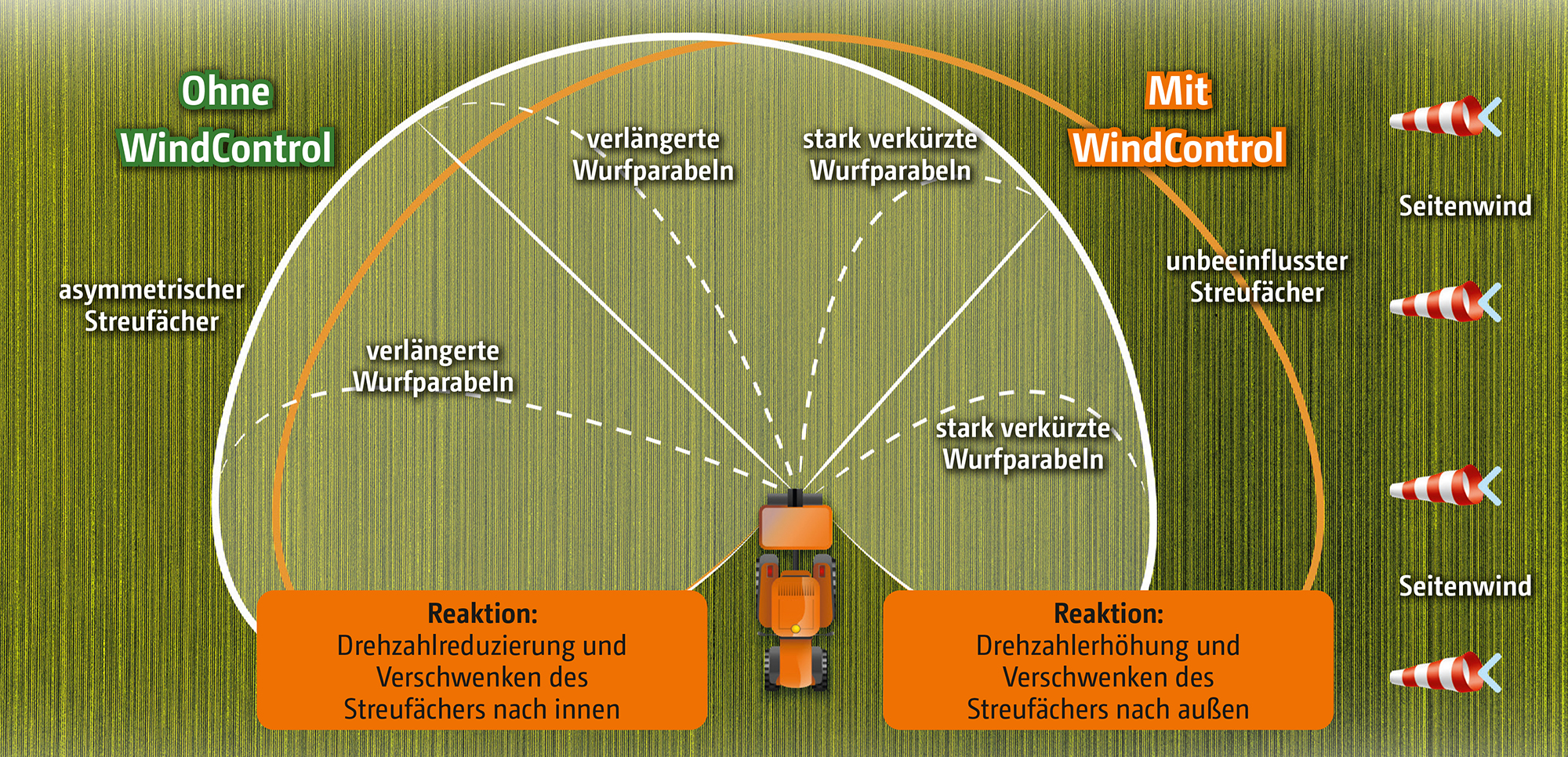The wind on your side
AMAZONE WindControl is now available independently of ArgusTwin
The wind is always blowing somewhere in the world and this represents a major challenge in maintaining an even fertiliser spread pattern. According to Prof. Dr. Karl Wild of the University of Applied Sciences, Dresden, the influence of wind on the spread pattern can also be constantly monitored and automatically compensated for by WindControl. WindControl can now also be used for the ZA-TS mounted spreaders and ZG-TS trailed spreaders independently of the ArgusTwin spread fan monitoring system.
The challenge posed by the wind when spreading mineral fertiliser
Winds can be strong or light, blow from different directions or blow at a constant speed one moment and in gusts the next. As a result, the effect of the wind on the spread pattern never stays the same. The wind speed and the wind direction vary both within the tramline and in comparison to the adjacent tramline.
In fertiliser spreading, wind is a parameter which the user cannot influence directly but must always keep in mind. As a rule, the main period of use for a centrifugal broadcaster is during the main growing season in spring. At this time of year, the site-related probability of having to work in windy conditions is particularly high when viewed over the year as a whole.
Headwinds or tailwinds stretch or compress the distribution pattern. The lateral distribution is not affected in either case, meaning that the throwing distance and therefore the effective working width remain unchanged. On the other hand, crosswinds change the lateral distribution significantly. The distribution pattern is compressed on one side and stretched on the other, resulting in an asymmetrical spread pattern. So the task of WindControl is to permanently monitor the spread pattern and adjust the fertiliser spreader settings in such a way that a symmetrical spread pattern is restored.
Windless conditions "at the touch of a button" widens the application window
A high-frequency wind sensor, mounted on the fertiliser spreader, records both the wind speed and the wind direction and transmits this information to the job computer. This processes the data with the forward speed and calculates new settings for both the delivery system and the spreading disc speed, which are then automatically adjusted. In a cross wind, the disc speed is increased on the side into the wind and the delivery system is rotated outwards. At the same time, the disc speed is decreased on the side facing away from the wind and the delivery system is turned inwards. This automatically counteracts the wind effect and ensures an accurate distribution. In addition, the use of WindControl results in larger time windows for fertilisation.
The wind at a glance
In addition to all the important parameters for fertiliser spreading, the operator always has an overview of the current wind situation such as the wind direction, wind strength and gustiness in the work menu. Traffic light colours are used to indicate the extent to which WindControl is still able to compensate for the effect of the wind. The system also issues a warning message if the limit to the amount of control is reached when the wind is too strong or if the gusting is changing too frequently.
The mast holding the wind sensor is automatically extended when the spreading discs are actuated. In doing so, the sensor protrudes above the tractor cab so as not to measure any turbulence generated by the tractor. When the spreading discs are switched off, the wind sensor retracts to the protected position between the tractor and the spreader. Manual operation is also possible.
Perfect results under any circumstances
AMAZONE offers the ArgusTwin spread fan monitoring system for the ZA-TS and ZG-TS centrifugal broadcasters in addition to WindControl. ArgusTwin enables the spread pattern from both the right and left hand disc to be monitored constantly by 14 radar sensors. If there are any deviations, the lateral distribution is automatically optimised by an adjustment via the electric delivery system. This can be carried out individually for each side, thereby ensuring optimum lateral distribution. ArgusTwin ensures a constant spread pattern even when spreading on slopes, using non-homogeneous spreading materials, or when moisture causes changes to the spreading process.
